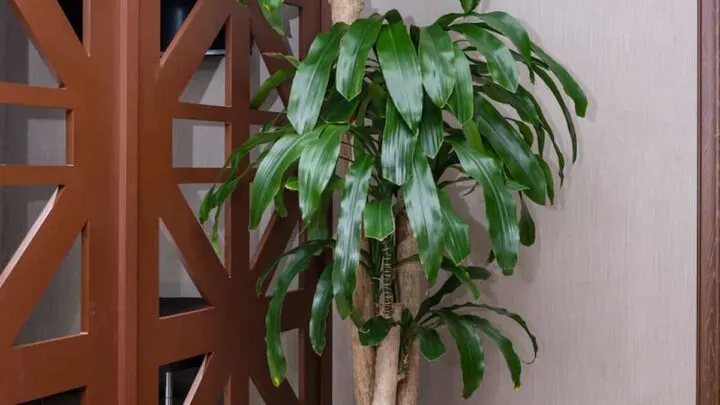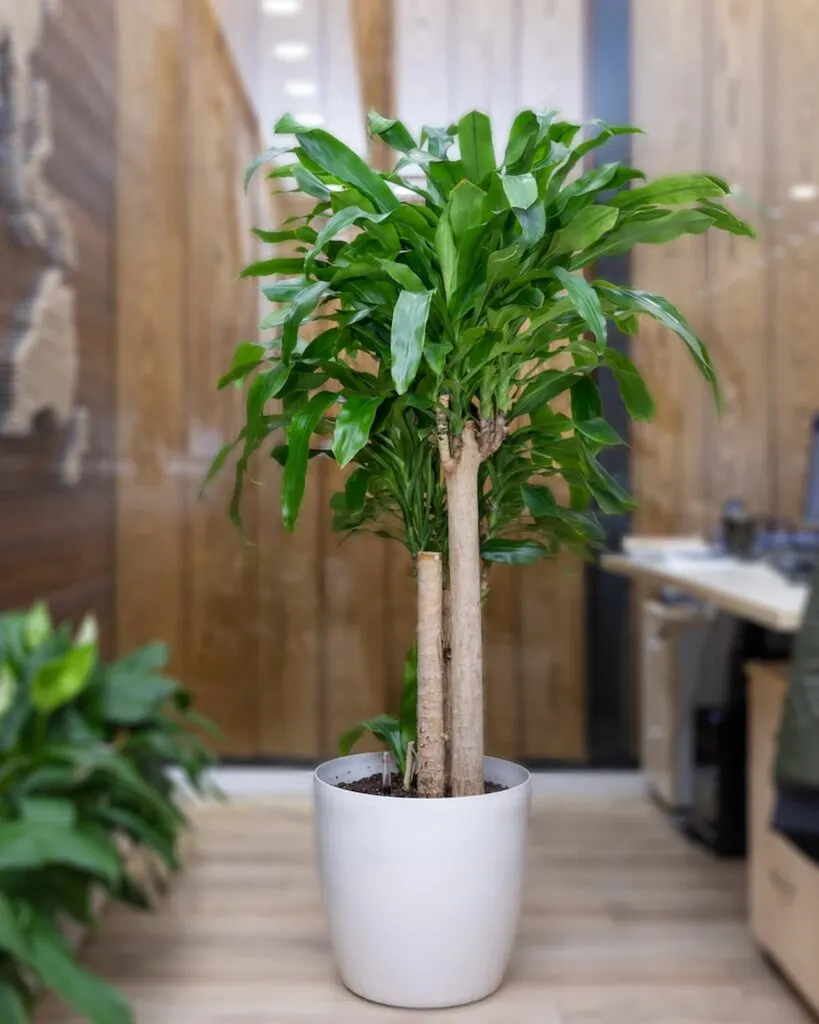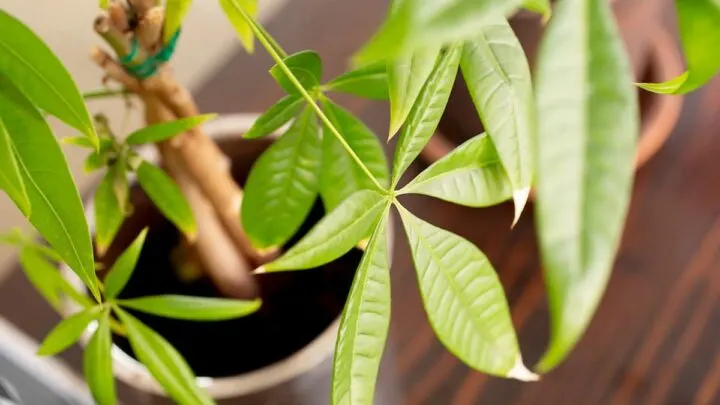Propagating your plants involves removing stems or leaves or dividing the roots to increase the number of plants you have from the “parent.” It can be done very simply, and for most plants, the same rules apply, and you don’t have to wait for your plant to be under the perfect conditions to flower and release seeds. Plus, growing a plant from a cutting takes less time than growing from seed and usually has a higher success rate since there is already vigorous growth. Propagating money trees is no exception, and with multiple ways to do so, one plant can give rise to many future money trees.
The most effective way to propagate a Pachira Money Tree is through cutting 1/4 inch of a branch and planting into soil. Removing the leaf nodes, dipping the cutting in root developing hormones, and then planting deep into the soil can lead to rapid growth.
With a few steps and patience, you can be well on your way to propagating your money tree and most other plants.

How to propagate Pachira “Money Tree”
Propagating most plants can be done similarly, and a couple of basic rules apply: Always use sterile, sharp tools to make cuts. This decreases the risk of infection. Only attempt to propagate healthy plants, as an unhealthy plant will likely give rise to unhealthy, unsuccessful cuttings.
Now that we know the basics, we can get into the specifics of propagating a Pachira Aquatica.
Choose your branch
Choose a healthy section on your plant that you’d wish to propagate from. It should have at least 2-3 nodes present and a few leaves to photosynthesize. Nodes are the swollen, knobby protrusions from which leaves and stems will grow.
When placed in the proper conditions, nodes will produce roots as well. This is why it’s essential to have a few nodes on your cutting, as this will give rise to the roots that will anchor your plant in the soil once it has developed.
Choose a stem that is between 5-6 inches in length. Avoid any soft or wilting stems; you want to give your cutting the best chance of survival by ensuring it is healthy enough to survive on its own while roots develop.
Making the cut
Using sterile, sharp scissors or a knife, you will want to cut about 1/4-1/2 inch below a node on your plant at a 45º. Make sure you have a few nodes on the stem above the cut node. When taking cuttings for propagation, it is good to take a few at a time, as not all cuttings will always root.
After taking your cutting, you can choose how you’d like for it to root: in water or soil. Both methods have reasonable success rates, and it ultimately boils down to personal preference. You should have your potting mix or container for water ready for the next step.

Rooting your cutting
Typically, money plants are rooted in soil, though they can also be propagated in water. Rooting in the soil is often more successful for these plants, though water propagation is the way to go if you’re interested in watching the root development process.
To root your cutting in soil, you can use rooting hormone, an artificial hormone designed to encourage rapid root development at the cut end of your plant. This product is readily available at plant nurseries or for purchase online. It’s not entirely necessary, and your plant can develop roots without the use of this hormone, but this is another way to ensure you will have some root growth.
Remove any leaves on the bottom 2-3 nodes, taking care to leave some healthy foliage at the top of the stem. Dip the portion of the stem that will be placed in the soil into the rooting powder. Gently shake off any extra powder on the stem; you need a light coating for it to be effective.
Then, you can place your cutting in a pot (with drainage) of well-draining soil and secure it with soil. A warm space with bright, indirect light should be where your plant lives for now. Water lightly and be patient as the root system will develop over the course of a few weeks.
To root your cutting in the water, you can follow the same first steps of soil propagation, including the rooting hormone. Instead of placing your cutting in a pot of soil, you can use a jar or glass filled about halfway with clean water. Place your cutting in the water, so the foliage is above the water line.
Giving your cutting a warm, indirectly lit space will also help encourage root growth. Change the water out every few days to avoid stagnation and potential stem rot. After a few weeks, roots will begin to develop, and once a substantial root system has developed, you can transplant your cuttings into well-draining soil.
The downside of rooting in water is that your plant’s roots are usually a bit more fragile and can take longer to establish than a plant grown directly in the soil. If you are taking multiple cuttings of your plant, then you may want to try each method to see where your preference lies.

How often should I water my money tree?
Money trees prefer to have their soil dry out in between waterings, so under the average household conditions watering once every 10-14 days is acceptable. In the months your plant is dormant, you can likely water once every 2-3 weeks since your plant is not using as much water for cellular processes and is not losing as much water through their leaves as they would under warmer conditions.
Avoid letting your plant sit in wet soil. This has the potential to breed bacteria that can cause root rot, a difficult thing to overcome once it has taken over your plant. It is better to err on the side of caution and underwater your plant rather than overwater.
When you water your money tree, it is essential you do so in an even and thorough manner. Light waterings do not contribute to growing a robust, healthy root system. Water your plant deeply until you see the water begin to flow out the drainage hole of your pot. This way of watering encourages your plant to “chase” the water, growing roots deeper into the soil. A healthier and stronger root system will be reflected in a vigorous, lush canopy of foliage.
Should I cut back my money tree?
Most plants will appreciate a good trim to remove any old or damaged leaves and encourage new growth. Other reasons to prune your money tree include reshaping the canopy and improving its overall appearance, especially if it has become somewhat leggy under low-light conditions.
When cutting back the leaves, you want to make sure your plant is in a period of active growth, either in the spring or summertime. Cutting back plants more than a few leaves when they are dormant can cause a shock to their system. They are running on reserve energy and won’t have the excess to divert to healing, which can make your plant a target for pests or diseases that it likely won’t be healthy enough to fight off on its own.

If your goal is to shape the tree, you can cut leaves off near the trunk. New growth will not occur in this area, so be mindful of where you make your cuts. Be careful to avoid cutting into your plant’s trunk.
You can customize your plant’s appearance by choosing where to prune. If you’re going for a bushier appearance, you’ll want to be more selective about where you are cutting. Cut above nodes that are pointing outwards if you want to increase the canopy’s width, and if you are going for height, then aim for more central stems or upwards-facing nodes.
Always use sterile and sharp tools when pruning your plants to avoid spreading bacteria between plants. Rubbing alcohol is an effective and inexpensive way to keep your tools clean and ready for any pruning or trimming that needs to be done.
When should I repot a money tree?
Money trees are relatively slow-growing plants that can stay in the same pot for up to 3 years before it needs to be placed in a larger pot with fresh soil. Signs of your plant being pot-bound include roots growing out of the drainage holes or, in rare cases, your plant being slowly pushed up and out of the pot due to continuous root growth.
If you want to keep your plant on the smaller side, you can trim up to 25% of its roots using sterile scissors to curb its growth. This should keep it about the same size and negate any need for repotting for another year or two.
When repotting a money tree, it is essential to do so only during the growing season if possible. Repotting can be stressful, and some roots will inevitably break or be damaged. Doing this when your plant is actively growing won’t be as detrimental to its overall health as when it is dormant.
Bigger pots aren’t always better; you want the pot to be proportional to the size of your plant. Try not to go more than 2 inches larger in diameter than your plant’s current pot size, and keep the depth in the range of what your plant is used to.
For example, you wouldn’t want to go from a regular pot to a wide, shallow pot. With extra room comes extra soil, which can hold more water than your plant’s roots are able to absorb. This time spent in soggy or moist soil can cause root rot, which is not something that any plant or plant lover wants to have to deal with.
Always use fresh soil when repotting to give your plant some nutrition to feed off of during its time of adjustment. Since it’s not advised to fertilize a plant within a month after being repotted, giving your money tree new soil to settle in should make the process easier, and your plant is less likely to deal with symptoms of transplant shock.
Depending on the size of your plant, this can take a few weeks or longer to bounce back from, so any way you can limit the stress on your plant will keep it healthier in the long run and less susceptible to pests or diseases.
Final Thoughts
Propagating your money tree is an easy process that can be very satisfying once you see the results. Not only will you increase the number of plants you have, but the parent plant will likely start generating even more new growth, which can later be propagated again.
Try out propagating your money tree, and you’ll find it is not nearly as intimidating a process as it might seem.

Hi there, my name is Allie and welcome to my blog; GareningWithAllie!
Much of what you see written here is just our personal experiences with gardening. Along with the content I write here, there is also a unique collection of gardening topics covered by some of our close friends. I hope you find everything you read here to be helpful, informative, and something that can make your gardening journey the most lovely experience ever! With that said, Happy Gardening!
